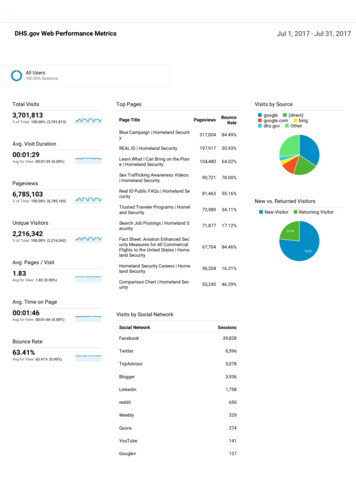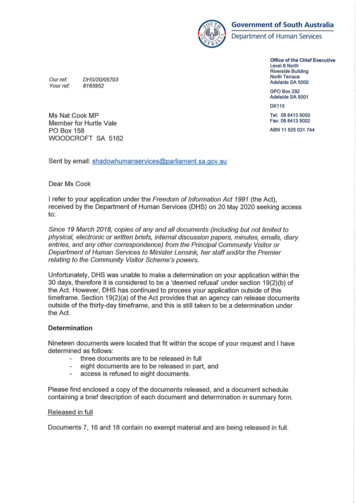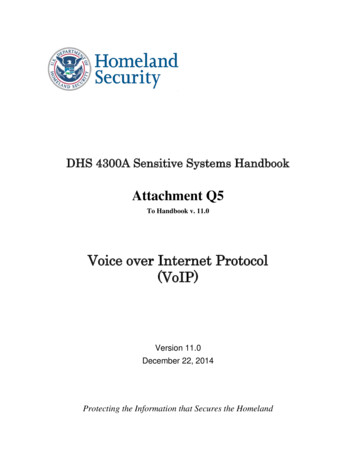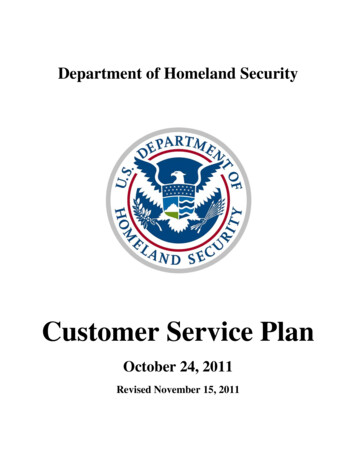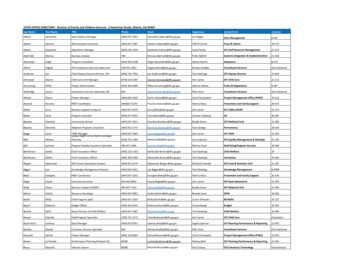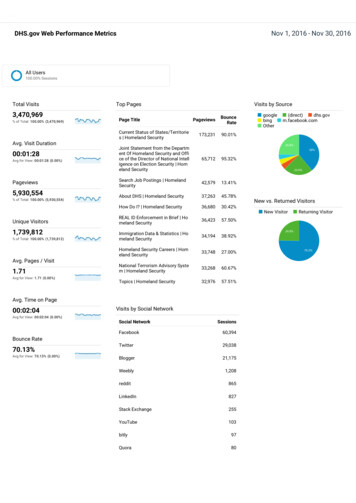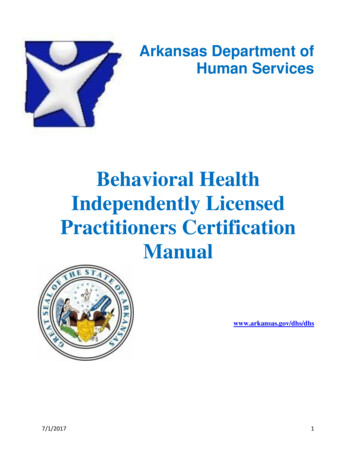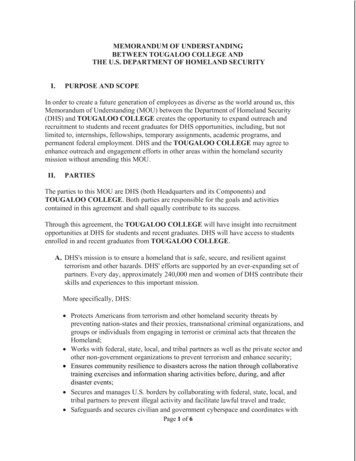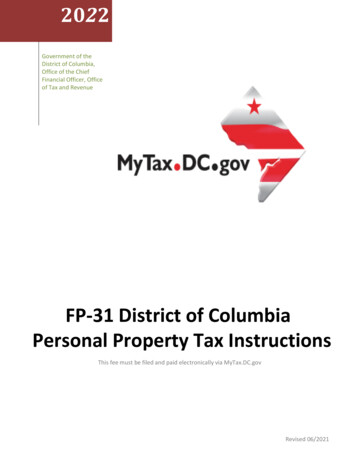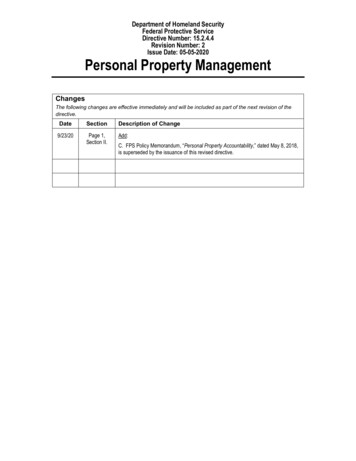
Transcription
Department of Homeland SecurityFederal Protective ServiceDirective Number: 15.2.4.4Revision Number: 2Issue Date: 05-05-2020Personal Property ManagementChangesThe following changes are effective immediately and will be included as part of the next revision of thedirective.DateSectionDescription of Change9/23/20Page 1,Section II.Add:C. FPS Policy Memorandum, “Personal Property Accountability,” dated May 8, 2018,is superseded by the issuance of this revised directive.
Department of Homeland SecurityFederal Protective ServiceDirective Number: 15.2.4.4Revision Number: 2Issue Date: 05-05-2020Personal Property ManagementI.PURPOSEThis directive establishes the Federal Protective Service (FPS) policy and assigns responsibilities for thePersonal Property Management Program to ensure compliance with Federal regulatory requirements.II.III.SCOPEA.This directive applies to all FPS elements in Headquarters, Regions, andMegaCenters. Use of Government-Furnished Property (GFP) or GovernmentFurnished Equipment (GFE) by FPS contractors is governed by the FederalAcquisition Regulation (FAR) and the terms of the particular contract.B.FPS Directive 15.2.4.4 Revision1, “Personal Property Management,” dated March 18,2019, is superseded by the issuance of this revised directive.AUTHORITIES/REFERENCESA.Department of Homeland Security (DHS) Directive 119-03 Revision 01, “PersonalProperty Management Program,” October 19, 2017.B.DHS Instruction Manual 119-03-001-01 Revision 01, “Personal Property AssetManagement Manual,” May 22, 2018.IV. DEFINITIONSA.Accountable Area is a specifically defined geographical or organizational locale inwhich personal property accountability is assigned to a designated AccountableProperty Officer.B.Accountable Personal Property is an asset that meets one or more of the followingcriteria: (1) expected useful life is two years or longer and an asset value of 5,000 or more;(2) that is classified as sensitive; (3) for which accountability or property control records aremaintained; or (4) otherwise warrants tracking in the property system of record.C.Accountable Property Officer (APO) is a government employee that is responsiblefor the overall accountability of personal property assigned to their accountable area.D.Assistant Accountable Property Officer (AAPO) is a government employee that isappointed by the APO to assist with the duties and responsibilities of the APO.E.Administrative Services Division (ASD) is the FPS Headquarters office thatcoordinates personal property activities with Regional Offices and MegaCenters andtheir designated contacts to manage accountable and sensitive personal property;acquires and disposes of excess/surplus furniture and equipment; and providestraining on the personal property management processes and procedures.Personal Property ManagementPage 1 of 4Directive 15.2.4.4 Revision 2
V.F.Excess Personal Property is personal property under the control of any Federalagency that is not required for that agency’s needs, as determined by the head of theagency or designee.G.National Utilization Officer (NUO) is a government employee assigned theresponsibility for promoting the acquisition and effective use of available excesspersonal property.H.Personal Property is any property, except real property. The term excludes recordsof the Federal Government.I.Property Custodian/Property Specialist (PC/PS) is a government employeeassigned the responsibility for performing daily personal property managementfunctions for the custodial area to which he/she is assigned.J.Property Management Branch (PMB) is an office within the Administrative ServicesDivision which provides internal policy, oversight, procedures and strategic planning toensure all personal property related activities (e.g., property management and training)are performed in compliance with relevant Federal laws and regulations.K.Personal Property Management consists of all the functions necessary for theproper determination of need, source, acquisition, receipt, accountability, utilization,maintenance, rehabilitation, storage, distribution, and disposal of personal property.L.Property Management Officer (PMO) is a government employee that is responsiblefor the overall accountability of personal property within the agency.M.Sunflower Asset Management System (SAMS) is a commercial off-the-shelfprogram used to manage assets and provide a wide range of functional capabilities inasset lifecycle management.N.Utilization is the process of identifying, using, processing, reporting, and transferringpersonal property within Federal agencies to fill current or future authorizedrequirements. It encompasses the redistribution, use, donation, sale, andabandonment or destruction of Government-owned personal property.RESPONSIBILITIESA.The Deputy Director for Technology & Innovation (DD T&I) appoints the Director,Administrative Services Division (ASD) as the Property Management Officer (PMO).B.The Property Management Officer (PMO):1.Develops and oversees the effective implementation of a personal propertymanagement program to ensure maximum utilization of personal property,adequate inventory control, accountability systems and proper disposal ofproperty throughout FPS;2.Appoints a National Utilization Officer (NUO) for internal and external screeningof excess property; and3.Appoints HQ Division Directors, Regional Directors and MegaCenter Managersas the APO for their accountable area.Personal Property ManagementPage 2 of 4Directive 15.2.4.4 Revision 2
C.The National Utilization Officer (NUO) promotes the acquisition and effective use ofavailable excess personal property from known sources, including DHS, GSA, or otherFederal agencies.D.The Accountable Property Officers (APOs):E.F.1.Provide support to the PMO in managing the day-to-day operational duties ofpersonal property asset management;2.Appoints an Assistant APO (GS-13 or higher), if required, to assist with theduties and responsibilities of the APO;3.Appoints PCs to manage personal property within their accountable area; and4.Assigns Contractor personnel, if required, as Inventory Clerks to assist PCs withmanaging personal property within SAMS.The Property Custodian/Property Specialist (PC/PS):1.Provide support to the APO in managing the day-to-day operational duties of thepersonal property asset management program;2.Ensure that newly-received accountable personal property is properly decaledwith a DHS barcode tag, and relevant data is entered into the SAMS; and3.Maintain current custodial records for all accountable personal property withintheir custodial area to include physically signing property down to the user levelthrough the use of SAMS generated hand receipts.Employees:1.Ensure that assigned personal property is properly cared for, handled, andutilized in an appropriate manner within or away from their duty station;2.Ensure that personal property in their possession, custody, or control is usedonly for government purposes, and not for individual or private use;3.Return assigned personal property to their PC/PS upon separation from FPS, orwhen the property is no longer required for their job performance; and4.Report incidents of lost, damaged, destroyed, or stolen personal propertyimmediately to their PC/PS and supervisor.VI. POLICY AND REQUIREMENTSA.General Policy. Personal property management and administration within FPS issubject to oversight by the DHS Chief Readiness Support Officer (OCRSO) within theManagement Directorate. OCRSO is responsible for establishing the DHS policy forpersonal property management of which the FPS Property Management program isrequired to comply. Personal property management functions within FPS arecomprised of two components:1.Administration and Oversight: This includes personnel responsible forPersonal Property ManagementPage 3 of 4Directive 15.2.4.4 Revision 2
Administrative Services Division (ASD) as the Property Management Officer (PMO). B. The Property Management Officer (PMO): 1. Develops and oversees the effective implementation of a personal property management program to ensure maximum utilization of personal property, adequate inventory control, accountability systems and proper disposal of
